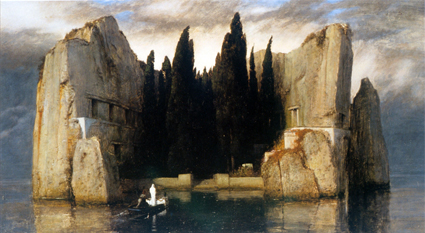The Swiss painter Arnold Bocklin died on this day in 1901, so today’s choice of painting is his masterpiece The Island of the Dead. Bocklin painted it in 1880, while convalescing on the island of Ischia after having caught the flu on a sketching trip to Naples. The composition proved so popular that he eventually painted five separate versions of the work (one of which ended up, with a certain ghoulish appropriateness, given its subject matter, in the private collection of Adolf Hitler). The picture reproduced here, which is the earliest of the five, can be found in the Kunstmuseum at Basel, the artist’s native town.
Bocklin is no longer a very well known painter, but he enjoyed an extremely high reputation in the later years of the nineteenth century. Originally trained at the Kunstakademie in Dusseldorf, he painted mythological subject paintings and landscapes in a moodily romantic style that was to remain entirely unaffected by the innovations of his contemporaries, the French Impressionists. He was a widely travelled artist, who found his ideal landscape amidst the myriad classical ruins and coastal towns of Italy, where he lived and worked for much of his life – and memories of which he imaginatively synthesised to create The Island of the Dead, which simultaneously evokes the Borromean islands in Lake Maggiore and the cemetery island of San Michele in the Venetian lagoon, with its towering cypress trees, so dark a hue of green they appear almost black. The work is thought to have been created in response to a request from Bocklin’s romantically inclined friend Marie Berna, who wanted a painting to provoke a mood of bittersweet reverie. Its title was thought up by the art dealer Fritz Gurlitt. Bocklin himself simply referred to it as “a picture for...


